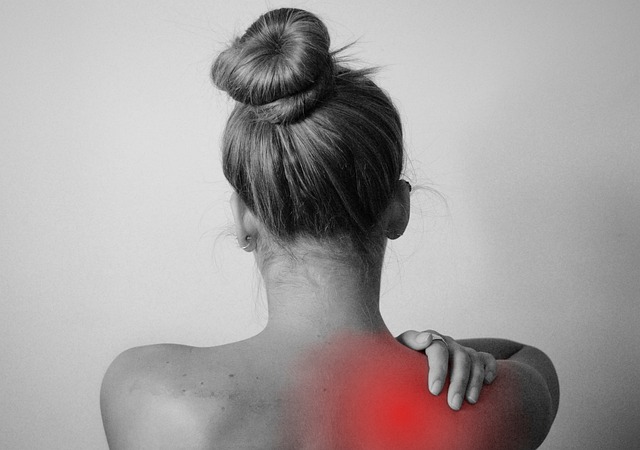What is the Rotator Cuff?
The rotator cuff is a term given to a group of four muscles that travel from the shoulder blade to the arm forming a ‘cuff’ surrounding the shoulder joint. The rotator cuff i) keeps the head of your upper arm firmly in the shoulder socket, and ii) is responsible for producing rotational and stabilising movements of the shoulder. Importantly, the rotator cuff stabilises your shoulder under load, namely the powerful movements of the big muscles around the shoulder (e.g. a tennis serve). (Perth Sports Medicine, OrthoNY)
The four main muscles are the supraspinatus, infraspinatus, teres minor and subscapularis (see below):
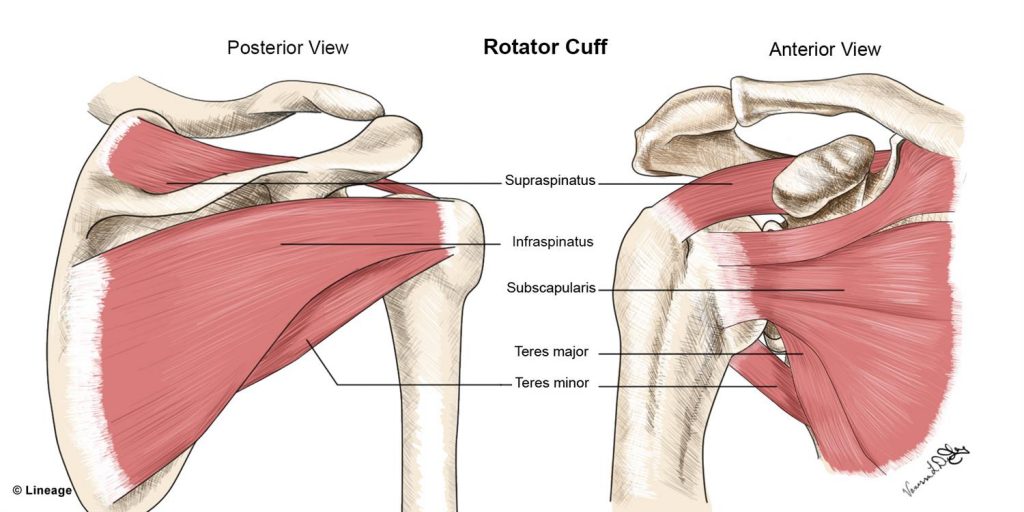
What is Rotator Cuff Injury?
The shoulder has more range of motion than any other joint, which also makes it prone to a number of different injuries.
There are 2 main causes of rotator cuff tears: degeneration and injury. An injury to the rotator cuff, such as a tear, may happen suddenly when falling on an outstretched hand, or can develop over time due to repetitive activities. A rotator cuff tear is quite common even more as we age with degeneration of the tissues. Injuries range from 9.7% in those up to 20 years old, increasing to 62% in patients 80 years and older (PubMed).
Tendons in the rotator cuff can be injured easily because they are moving within a tight space. When the shoulder is turned or lifted at the limit of its natural range of movement, the tendons in this tight space move and can bump or rub against a bony knob (the acromion) above them or against a ligament towards the front of the shoulder. The full spectrum of rotator cuff injuries runs from tendinopathy to partial tears, and finally complete tears.
(Ortho NY; Harvard; Hopkins Medicine; PubMed)
What are the Symptoms of a Rotator Cuff Injury?
The following are the most common symptoms of a rotator cuff tear:
- Recurring pain and difficulty, especially with certain activities that involve lifting the arms or rotating the shoulders
- Pain and weakness in the shoulder, particularly at night, preventing you from sleeping on your injured side
- Grating or cracking sounds when you move your arm
- Limited arm movement
- Muscle weakness
How do you Prevent Rotator Cuff Injury?
If you are an athlete that plays an overhead motion sport, practice recurrent lifting at the gym (or with your kids!). It’s important to practice exercises that strengthen your rotator cuff, to prevent injury. For those of us with poor posture it’s also important to mindfully correct it, to keep the rotator cuff in place. Some exercises include:
Parallel Arm Shoulder Stretch

Hold this stretch for 20 seconds each arm.
Reverse Shoulder Stretch
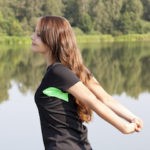
Clasp hands behind your back and slowly lift upwards until you feel tension. Hold this stretch for 20 seconds.
Cow Face Pose
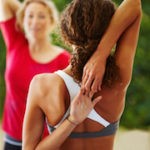
Gently reach your hands behind your back, as illustrated and stretch your hands toward each other. If this stretch is challenging, hold a hand towel above your head as you stretch back, then grab the other end of the towel with your opposite hand. Pull lightly on the towel with the upper hand until you feel a gentle stretch. Hold for 30 seconds.
Downward Facing Dog
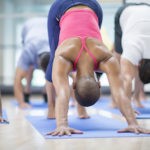
Down dog both stretches and strengthens the shoulders and rotator cuffs muscles (along with muscles throughout the body!) Start in a neutral position on your hands and knees before gently pushing yourself into downward facing dog. Don’t force your legs straight – a straight back (neutral spine) and properly aligned shoulders are more important than straight legs, so keep your knees bent if that’s more functional for you.
Overhead Hanging
Stable Massage therapist Konrad emphasises: “Regular overhead hanging has been shown to be a very effective way to both prevent and correct many types of shoulder injuries.”
Check out this article and video below for more information and step by step instructions.
Rotator Cuff Injury Treatment
The treatment differs depending on the severity of the injury. If a complete tear occurs, reconstructive surgery will be required in order to regain muscle function. There is ample medical evidence to suggest that non-surgical interventions such as rehab and strengthening over time, can restore correct functioning of the muscle/ligament/tendon if the tear is only partial.
Massage therapy for rotator cuff injuries helps to decrease inflammation and pain in the area, release scar tissue, loosen tight and tense muscles and increase range of motion in the shoulder girdle. Resting the shoulder joint is a very important treatment for a rotator cuff injury, but keeping the joint immobile for extended periods of time can cause the muscles and tendons to “freeze” or get stuck, making it incredibly difficult and painful to move (East Bridge Massage). This is otherwise known as “frozen shoulder”. So to prevent this strengthening and stretching exercises are equally important for recovery (depending on the severity of your injury and on the advice of your therapist).
If the injury is severe and needs surgery, massage therapy can be an important part of recovery and treatment. If you are experiencing symptoms of rotator cuff injury, first visit your GP to assess the underlying causes. Then on the advice of your GP visit your physical therapist for targeted relief, and an ongoing treatment plan. A single appointment will most likely provide immediate relief but there is no magic bullet for chronic aches and pains. Long term improvements will happen only with ongoing therapy and an active treatment plan.
[addthis tool=”addthis_inline_share_toolbox_tylg”]
